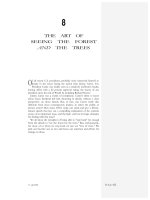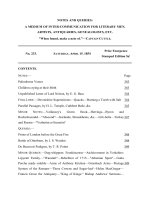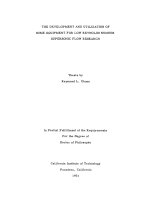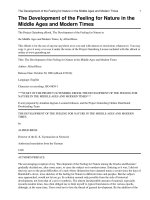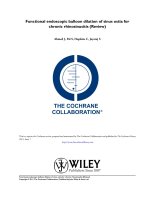atmospheric pressure fabrication of sno2 nanowires for
Bạn đang xem bản rút gọn của tài liệu. Xem và tải ngay bản đầy đủ của tài liệu tại đây (1.43 MB, 41 trang )
Accepted Manuscript
Title: Atmospheric pressure fabrication of SnO
2
-nanowires for
highly sensitive CO and CH
4
detection
Authors: Anton K
¨
ock, Alexandra Tischner, Thomas Maier,
Michael Kast, Christian Edtmaier, Christian Gspan, Gerald
Kothleitner
PII: S0925-4005(09)00172-5
DOI: doi:10.1016/j.snb.2009.02.055
Reference: SNB 11361
To appear in: Sensors and Actuators B
Received date: 22-10-2008
Revised date: 17-12-2008
Accepted date: 20-2-2009
Please cite this article as: A. K
¨
ock, A. Tischner, T. Maier, M. Kast, C. Edtmaier,
C. Gspan, G. Kothleitner, Atmospheric pressure fabrication of SnO
2
-nanowires for
highly sensitive CO and CH
4
detection, Sensors and Actuators B: Chemical (2008),
doi:10.1016/j.snb.2009.02.055
This is a PDF file of an unedited manuscript that has been accepted for publication.
As a service to our customers we are providing this early version of the manuscript.
The manuscript will undergo copyediting, typesetting, and review of the resulting proof
before it is published in its final form. Please note that during the production process
errors may be discovered which could affect the content, and all legal disclaimers that
apply to the journal pertain.
Page 1 of 40
Accepted Manuscript
hot plate
Si wafer
air atomizing
nozzle
carrier
gas N
2
solution
shutter
wafer
carrier
siphon
height
solution
Fig. 1
Page 2 of 40
Accepted Manuscript
Figure 2
Page 3 of 40
Accepted Manuscript
Figure 3
Page 4 of 40
Accepted Manuscript
Fig. 4
Page 5 of 40
Accepted Manuscript
Figure 5
Page 6 of 40
Accepted Manuscript
Figure 6
Page 7 of 40
Accepted Manuscript
Fig. 7 new as pdf
Page 8 of 40
Accepted Manuscript
Fig. 7 new as ppt
Page 9 of 40
Accepted Manuscript
2.2E+06
2.3E+06
2.4E+06
2.5E+06
2.6E+06
2.7E+06
2.8E+06
2.9E+06
0
10
20
30
40
50
60
70
80
90
100
300 600 900 1200 1500 1800 2100 2400
Sensor Resistance [Ω]
Humidity [%]
Time [s]
rH meas (%)
Sensor R [Ω]
Fig. 8 color
Page 10 of 40
Accepted Manuscript
2.2E+06
2.3E+06
2.4E+06
2.5E+06
2.6E+06
2.7E+06
2.8E+06
2.9E+06
0
10
20
30
40
50
60
70
80
90
100
300 600 900 1200 1500 1800 2100 2400
Sensor Resistance [Ω]
Humidity [%]
Time [s]
rH meas (%)
Sensor R [Ω]
Fig. 8
Page 11 of 40
Accepted Manuscript
1.010E+04
1.015E+04
1.020E+04
1.025E+04
1.030E+04
1.035E+04
1.040E+04
1.045E+04
1.050E+04
1.055E+04
1.060E+04
0
1
2
3
4
5
6
7
8
9
10
500 1500 2500 3500 4500 5500
Sensor Resistance [Ω]
CO Flow [sccm]
Time [s]
CO flow
Sensor R [Ω]
Fig. 9 color
Page 12 of 40
Accepted Manuscript
1.010E+04
1.015E+04
1.020E+04
1.025E+04
1.030E+04
1.035E+04
1.040E+04
1.045E+04
1.050E+04
1.055E+04
1.060E+04
0
1
2
3
4
5
6
7
8
9
10
500 1500 2500 3500 4500 5500
Sensor Resistance [Ω]
CO Flow [sccm]
Time [s]
CO flow
Sensor R [Ω]
Fig. 9
Page 13 of 40
Accepted Manuscript
2.70E+06
2.75E+06
2.80E+06
2.85E+06
2.90E+06
2.95E+06
3.00E+06
0
20
40
60
80
100
120
140
160
180
200
300 600 900 1200 1500 1800 2100 2400
Sensor Resistance [Ω]
CH
4
Flow [sccm]
Time [s]
CH
4
flow
Sensor R
Fig. 10 color
Page 14 of 40
Accepted Manuscript
2.70E+06
2.75E+06
2.80E+06
2.85E+06
2.90E+06
2.95E+06
3.00E+06
0
20
40
60
80
100
120
140
160
180
200
300 600 900 1200 1500 1800 2100 2400
Sensor Resistance [Ω]
CH
4
Flow [sccm]
Time [s]
CH
4
flow
Sensor R
Fig. 10
Page 15 of 40
Accepted Manuscript
2.80E+06
2.82E+06
2.84E+06
2.86E+06
2.88E+06
2.90E+06
2.92E+06
2.94E+06
2.96E+06
2.98E+06
3.00E+06
0.0
0.1
0.2
0.3
0.4
0.5
0.6
0.7
0.8
0.9
1.0
300 600 900 1200 1500 1800 2100 2400
Sensor Resistance [Ω]
CH
4
Flow [sccm]
Time [s]
CH
4
flow
Sensor R [Ω]
Fig. 11 color
Page 16 of 40
Accepted Manuscript
2.80E+06
2.82E+06
2.84E+06
2.86E+06
2.88E+06
2.90E+06
2.92E+06
2.94E+06
2.96E+06
2.98E+06
3.00E+06
0.0
0.1
0.2
0.3
0.4
0.5
0.6
0.7
0.8
0.9
1.0
300 600 900 1200 1500 1800 2100 2400
Sensor Resistance [Ω]
CH
4
Flow [sccm]
Time [s]
CH
4
flow
Sensor R [Ω]
Fig. 11
Page 17 of 40
Accepted Manuscript
1
Atmospheric pressure fabrication of SnO
2
-nanowires for
highly sensitive CO and CH
4
detection
Anton Köck*
1
, Alexandra Tischner
1
, Thomas Maier
1
, Michael Kast
1
, Christian Edtmaier
2
, Christian
Gspan
3
, and Gerald Kothleitner
3
1
Division Nano-System-Technologies, Austrian Research Centers GmbH – ARC, 1220 Vienna, Austria
2
Institute of Chemical Technologies and Analytics, Vienna University of Technology, 1040 Vienna,
Austria
3
Institute for Electron Microscopy and Fine Structure Research, Graz University of Technology, and
Centre for Electron Microscopy Graz, 8010 Graz, Austria
Manuscript
Click here to view linked References
Page 18 of 40
Accepted Manuscript
2
ABSTRACT
In this paper we report on a new approach for the fabrication of ultra long single crystalline SnO
2
-
nanowires for gas sensing applications based on a combined spray pyrolysis and annealing process. The
SnO
2
-nanowires are grown on SiO
2
-coated Si-substrates and exhibit diameters of 30 - 400 nm and
lengths up to several 100 µm. The whole SnO
2
-nanowire fabrication procedure is performed at
atmospheric pressure and requires no vacuum. The experimental results suggest a competing
evaporation and condensation process, which converts the nanocrystalline SnO
2
-films into single
crystalline SnO
2
-nanowires directly on the chip. For the realization of gas sensors the SnO
2
-nanowires
are transferred to another SiO
2
-coated Si-substrate. Evaporation of Ti/Au contact pads on both ends of
single SnO
2
-nanowires enables their direct use as sensing elements. The devices are very sensitive, are
able to detect humidity, and concentrations of CO and CH
4
as low as a few ppm at operating
temperatures of 200 – 250°C. We believe that our fabrication procedure might be the technology of
choice for the controlled fabrication of SnO
2
-nanowires as highly sensitive gas sensing elements on a
wafer scale.
Page 19 of 40
Accepted Manuscript
3
1. Introduction
Numerous novel applications ranging from industrial process control and safety systems to
environmental monitoring or disease diagnostics in medicine have a strongly increasing demand for
highly sensitive gas detecting devices. Metal oxide based gas sensors, which rely on changes of
electrical conductance due to the interaction with the surrounding gas, have been developed over the
years to established devices. Especially the employment of thin films has improved the sensor
performance [1–4]. Among all metal oxides SnO
2
has become the most prominent sensing material and
many SnO
2
-based sensor devices have been realized so far [5–7]. The implementation of MEMS
technology has further advanced the gas sensing device performance. Thermally insulated micro
hotplates, for example, have been integrated as platforms on CMOS-chips for the realization of sensor
arrays comprising different polycrystalline materials and allow for adjustment of different temperatures
to provide a certain level of selectivity [8–10].
A most powerful strategy to improve sensor performance is the implementation of nanostructured
materials, such as nanocrystalline films or nanowires, which have a high surface to volume ratio and
thus a strong interaction between the surrounding gas and the material. Several gas detecting devices
utilizing metal oxide nanocrystals [11, 12], nanorods [13–15], or nanosheets [16], for example, have
been realized. Nanocrystalline sensing films, however, may have the problem of long-term sensor
poisoning. Therefore with respect to device stability single crystalline nanowires are favorable.
Numerous fascinating devices based on nanowires as sensing probes for both chemical and as well as
biological analysis have been demonstrated so far [17, 18]. Excellent reviews of nanowire sensor
devices are given in references [19, 20]. The range of nanowire materials encompasses metals [21, 22],
semiconductors [17, 23–25], metal oxides [26, 27], carbon nanotubes [28, 29], and polymers [30, 31].
For gas sensing applications, which often require measurements in harsh environments, metal oxide
nanowires are of particular importance because they have a high chemical resistance and thermal
stability. Gas sensing has been successfully achieved with a variety of metal oxide nanowires, such as
Page 20 of 40
Accepted Manuscript
4
In
2
O
3
nanowires [27, 32] or WO
3
nanowire networks [33]. Also ZnO nanorods and nanowires have been
employed for sensing applications [34, 35], a field effect transistor configuration has been used for NO
2
and NH
3
sensing [36]. Arrays of individual nano- and mesowire sensors have been developed for
hydrogen versus CO monoxide discrimination as a step towards the electronic nose [37].
As SnO
2
has been the most prominent sensing material in conventional gas sensors, the major focus
has been put on the fabrication and implementation of SnO
2
nanobelts and nanowires as sensing probes.
Nanosensors based on SnO
2
-belts with high sensitivity for CO, NO
2
and Ethanol have been reported
[26]. Detection of CO and O
2
has been achieved with template grown SnO
2
nanowires, while enhanced
gas sensing has been demonstrated with Pd functionalized SnO
2
nanowires [38]. Tin oxide nanobelts
have been integrated with microsystems for nerve agent detection [39]. Modified SnO
2
nanoribbons and
nanowires have been developed for the detection of H
2
S [40]; CO and humidity have been detected with
single SnO
2
nanowires [41].
In this paper we report on atmospheric pressure synthesis of single crystalline SnO
2
-nanowires directly
on the Si-chip by spray pyrolysis and subsequent annealing. Our two-step SnO
2
-nanowire fabrication
procedure is very simple, requires no vacuum, and allows for straightforward upscaling the possible
substrate to 6”-wafer size. We believe that our fabrication procedure might be the technology of choice
for the controlled fabrication of SnO
2
-nanowires as highly sensitive gas sensing elements on a wafer
scale.
2. Experimental
The SnO
2
-nanowires are fabricated in a two-step procedure: In a first step nanocrystalline SnO
2
-films
are fabricated by a spray pyrolysis process. These SnO
2
films have already been employed by us as gas
sensing elements. Recently we have reported on SnO
2
thin-films gas sensors (thickness 50 nm - 100 nm)
that show high sensitivity to humidity and are able to detect carbon monoxide down to a concentration
of less than 5 ppm [42]. The experimental setup, shown in Fig. 1, consists of a 30 x 30 cm
2
hotplate and
a siphon-fed spray setup with an air atomizing spray nozzle (QuickMist QMJML, Spraying Systems
Co.), which is positioned on the side of the hot plate allowing the atomized spray to flow parallel to the
Page 21 of 40
Accepted Manuscript
5
surface; distance to the samples is 20 cm. N
2
with a pressure of 0.8 bar is used as carrier gas; a siphon
height of 10 cm results in a solution flow rate of 10 ml/min.
Si-wafers coated with a 750 nm thick SiO
2
-layer were used as substrates for SnO
2
-film deposition.
Three different types of samples were prepared: The 2 cm x 2 cm large substrates were either directly
used for SnO
2
deposition or sputter coated with a 40 nm thick Cu-layer, or 5 nm thick Au-layer,
respectively, before SnO
2
deposition in order to study possible influence of catalytic metal films. The
samples were directly placed on the hotplate heated up to a temperature of 500°C. Spraying a 0.28 molar
solution of tin chloride pentahydrate in ethyl acetate results in the formation of nanocrystalline SnO
2
-
layers on the substrates with a deposition rate of ~100 nm/min according to the (simplified) chemical
reaction
SnCl
4
+ 2H
2
O = SnO
2
+ 4HCl. (1)
Spray duration was 2 min so that the resulting SnO
2
film thickness on all samples was around 200 nm.
Subsequent to the deposition process, the samples were removed from the hotplate and immediately
cooled to room temperature. The whole deposition procedure was performed in ambient air.
The second SnO
2
-nanowire fabrication step is an annealing process: a tube furnace was heated up to
temperatures of 800°C, 900°C and 1000°C. The SnO
2
-coated samples were placed into the heated
furnace; due to the small thermal mass ramp-up time was negligible. The annealing process was
performed in Ar-gas at atmospheric pressure, a slight Ar-gas flow was used during the process.
Annealing time was 60 min for all samples, only the temperature was varied as critical parameter in
order to find the best conditions for synthesizing ultra-long SnO
2
nanowires for sensor applications. All
samples were annealed individually to exclude any mutual material growth or deposition of vaporized
products. Immediately after the annealing process the samples were removed from the furnace and
cooled in ambient air to room temperature.
3. Results and Discussion
3.1 Tin oxide nanowire characterization
Page 22 of 40
Accepted Manuscript
6
The following experimental results were found: For annealing temperature of 800°C no nanowire
growth was observed on all three types of samples. The samples with intermediate Cu- and Au-layers
annealed at 900°C showed white wool-like nanowires covering especially around the edges of the
samples. A scanning electron microscopy image (SEM) shows SnO
2
-nanowires with diameters of 30 -
400 nm and lengths up to several 100 µm directly on the samples (Fig. 2). The nanowire density was
lower and nanowires tend to be shorter towards the middle of the samples. Growth of nanowires with
lengths up to several 10 µm was also observed on samples without metallic intermediate layer. Areal
density of nanowires, however, was orders of magnitude less than compared to samples with metallic
intermediate layer. Annealing at a temperature of 1000°C showed also wool-like nanowire growth on
samples with intermediate Cu- and Au layers, but SEM analysis reveal that the nanowires significantly
start branching and interconnecting to each other, which makes further processing of single nanowires as
gas sensing elements difficult. A few nanowires are also found randomly distributed on samples without
intermediate metal layers, but nanowires are only a few µm long.
The SnO
2
-nanowires have been investigated with a transmission electron microscope (TEM). Bright
field images and electron diffraction patterns were acquired using a Tecnai F20 with a field emission
gun (FEG) operating at 200 kV. The microscope has a post column energy filter (Gatan Imaging Filter,
GIF) and the images were recorded in zero-loss filtered mode, using a 10 eV wide slit (i.e. elastically
scattered electrons only). The selected area electron diffraction pattern of a typical SnO
2
-nanowire
fabricated at annealing temperatures of 900°C is shown in Fig. 3 and represents a cubic crystal with
orientation [001]. The SnO
2
-nanowires are found to grow either straight or alternating along two distinct
directions, as is obvious from the TEM bright field image shown in Fig. 4. Fig. 5 represents the high
resolution (HR) TEM detail of the SnO
2
-nanowire indicated in the inset of Fig. 4. The SnO
2
-nanowire is
single crystalline and the surface is very smooth. The Fourier transformation (FFT) of the HRTEM
image shows two preferred growth directions [100] and [110]. As a result of these two growth directions
some nanowires show 45° degree facets (Fig. 5). The TEM-micrograph of a nanowire with a diameter of
Page 23 of 40
Accepted Manuscript
7
~40 nm is shown in Fig. 6. The nanowire is also single crystalline, but shows pyramidal shaped surface
roughness, which is typically found on nanowires having diameters below about 100 nm.
The physical mechanism of the two-step SnO
2
-nanowire fabrication procedure in our case is not yet
understood. Several growth technologies have been reported so far. SnO
2
-nanowires have often been
synthesized by thermal evaporation of SnO
2
powder, vapour phase transport and resultant condensation
on a proper substrate with and without use of metal catalyst [43-45]. Individual SnO
2
nanowires have
also been fabricated by chemical vapour deposition of a molecular precursor [41]. Laser ablation [46], or
electrochemical growth in pores of templates [47], for example, have also been reported. Several growth
mechanisms for the synthesis of one dimensional nanowires, such as the vapour-liquid-solid or vapour-
solid mechanism, have been elaborated and are summarized in some excellent reviews [48-50].
Among all technologies our fabrication scheme seems to be mostly related to the vapour-solid-process
as described in Ref. 48. Normally, the source material is thermally vaporized, a carrier gas such as Ar is
used for the transport, and the resultant vapour phase condenses on a substrate, which is placed
downstream of the source material. In our case, however, the SnO
2
-nanowires are fabricated on a single
chip, which might indicate a competing SnO
2
evaporation and subsequent condensation process
immediately above the sample surface: The nanocrystalline SnO
2
film
,
which has been deposited by
spray pyrolysis on the Si-chip, is acting as the source material. X-ray photoelectron spectroscopy
analysis clearly proves that the deposited films are composed of SnO
2
and no other oxidation state, such
as SnO, is contained in the films [42]. When the samples are heated at atmospheric pressure, the SnO
2
starts to vaporize into molecular species. As no carrier gas is used in our case for possible vapour phase
transportation, the SnO
2
-molecules can immediately start to precipitate on specific crystal facets of the
nanocrystalline SnO
2
grains, which are statistically distributed in all crystal orientations on the Si-
substrate. The newly arrived molecules continue to deposit on the formed nucleus and the side surfaces
that have lower energy start to form. Due to the high mobility of the molecules, the next molecules
diffuse on the surface, move to the lower energy sites at the growth front and form the nanowires.
Page 24 of 40
Accepted Manuscript
8
In order to support this possible growth mechanism explanation, the second SnO
2
-nanowire
fabrication step, i.e. the annealing process, has been performed in vacuum at a pressure of 2
.
10
-3
mbar.
No nanowire growth has been achieved under these conditions. The same annealing experiments have
been performed at higher pressure of 1.33 mbar in an environmental scanning electron microscope
(ESEM) with an integrated furnace in order to study the nanowire growth process in-situ. By stepwise
increasing the temperature, a structural change of the nanocrystalline SnO
2
-film was observable for
temperatures above 850°C. However, the SnO
2
-material simply vaporized, no nanowire growth due to
condensation was observed. From these experimental results we conclude that the annealing process
requires conditions around atmospheric pressure, which suppresses the evaporation of the SnO
2
-material
from the surface and favours the subsequent condensation in order to form the nanowires.
While these results are an indication for the proposed competing evaporation and condensation
process directly on the surface of the sample, the influence of the intermediate metal layers Cu and Au,
is not understood. It is obvious from the experiments that these metal layers strongly trigger the
nanowire growth, which indicates a metal-catalytic vapour-liquid-solid (VLS) growth mechanism [49].
The metal layers are underneath the SnO
2
-nanowire at the interface to the SiO
2
-layer, where basically no
vapour can influence the growth. Due to the nanocrystalline structure the metal might diffuse along
grain boundaries to the surface and start to trigger a VLS-growth. In the TEM studies, however, we have
not found any evidence for Cu or Au clusters at the tips of the SnO
2
-nanowires so far, which would be a
clear evidence for a VLS growth mechanism. First experiments with Cu and Au-layers on top of the
SnO
2
-films have also been performed and SnO
2
-nanowire growth has also been achieved. The
nanowires, however, are much shorter than in case of the intermediate metal films, and are strongly
branched and interconnected. Additional nanowire growth experiments will be carried out in order to
fully understand the growth mechanism and to clarify whether it is a VLS dominated mechanism or not.
3.2 Tin oxide nanowire sensors
